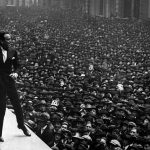5 Speaking Habits You Need To Adjust Depending On The Size Of Your Audience
When you’re preparing for a speaking gig, you’ve got to ask yourself a few questions: What am I going to say? How long do I have to present? Who will be in the audience? Those are all important questions. But there’s one that’s easy to overlook yet can have a serious impact on how well you do: How many people am I speaking to?
The size of your audience can affect how well your message is received in more ways than you might expect. Here are the key things to pay attention to as you tailor your delivery to small and large crowds. Nail these, and you’ll be an effective speaker, no matter the setting or occasion.
1. How Hard You Concentrate
When speaking in front of a large audience, you usually have to concentrate on what you’re doing more intensely. It’s kind of like biking against a hard wind—you have to concentrate on what you’re saying, where you’re looking, and how you’re breathing. The larger your audience, the steeper the hill. You have to be “all in.”
Things tend to be easier in more intimate settings. With smaller crowds, you can relax your focus a bit. Sure, you still have to concentrate on what you’re doing, but you can also tune into the audience a bit more easily. You keep peddling, but now you can look around and see what’s happening. It’s not necessarily that speaking to smaller audiences is always easier, but it does mean you can relax your concentration a bit—you can flow in and out. If you use the same level of focus in smaller settings, you may come off as too intense.
2. Your Voice Quality
When you speak in front of a large group, chances are you’ll be using a microphone. Whether you have a loud or a quiet voice, the audio technician can adjust the sound levels to make sure you sound great.
I once had one of my clients send me video clips of him speaking. He sounded great—he had a strong, resonant voice. Then I met him and was surprised to find he sounded strained and raspy. But it made sense why he’d complained about how tired his voice got at the end of a day of speaking. Achieving that effect can be taxing.
When you speak to a small group, you usually won’t have the luxury of a microphone. That means that if you have a voice that’s too high or too low, you may need to work on your “resonance” if you want to have the same effect on your audience. These are a few tips that can help you develop a stronger speaking voice.
3. Feeling Out The Audience
When you’re in front of a large audience, the feedback you can sense from the crowd is rhythmic. You can’t always see your audience (often depending on the lighting), but you can usually feel their energy. It’s all about connecting with the audience as a whole.
When I was a theater director, I would watch the audience on opening night: When were they riveted, all together? When were they fragmented, shifting, moving, out of sync? By gauging the audience’s cohesion, I could usually fine-tune the show.
When you’re in front of a small audience, though, you can see everyone. You can establish eye contact. You can notice side conversations. You still need to aim for cohesion, but you have more dimensional tools at your disposal—you can change your voice, accelerate your pacing, move toward people, and so on.
4. Style
When you speak in front of a large audience, a live video feed of your talk may be projected onto screens that frame you in close-up for the crowd. In this type of format, a bigger-than-life rhetorical style can backfire (at least in business contexts). Counterintuitive as it may sound, you actually need to have a more personal approach, more as though you were speaking to somebody on-on-one. You maintain audience attention with small moves and subtle expressions that ebb and flow.
It’s actually in smaller settings where you may need to project yourself bigger—since you don’t have cameras to zoom in for a close-up. You need to draw your audience in with a dynamic style that combines gestures, rhythm, and spontaneous facial expressions. When you have a more multidimensional style, you pique your listeners’ interest again and again over the course of your talk.
5. How (And How Much) You Move
For talks in front of large crowds that are recorded on video, you need to consider where the cameras are placed and how many of them are trained on you.
If there’s just one camera, you can’t move impulsively because the camera operator will need to follow you with a wide shot. This can make you come across as distant. You’ll be on a big screen, but you’ll be small. If there are two or more cameras, you have more options in terms of movement, but you still have to think about who’s in control—is it you or a director?
For example, one of my clients was giving the keynote at a big corporate Starbucks meeting where there were three cameras. I asked him if he discussed when he wanted close-ups. “What? I never thought about that,” he said.
Think about the last time you watched a football game. How many times did the shots change? Likewise, how many times do you want to change shots? These can usually be planned in advance with whoever’s producing the recorded version of your talk. To increase your impact, you have to consider close-ups, super close-ups, half-shots, and full-shots. It’s a lot to think about, so it’s important to negotiate control, then adjust how you move on stage accordingly.
When you speak to a small group, you usually don’t have to think about camera angles, but you do have to think about how to orchestrate your audience’s attention by creating contrast with your movement—through peaks and valleys. You can move closer in for a (camera-less) “close-up.” You can walk around and then pause for emphasis. You are in total control, not a videographer.
So when you prepare for your next presentation, remember to take into account the size of your audience. Your message may be the same, but the way you deliver it shouldn’t be.
Fast Company , Read Full Story
(29)














